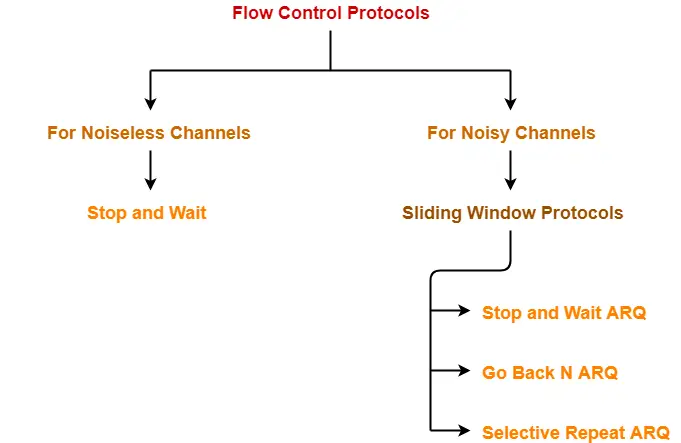Flow Control Protocols-
In computer networking, there are various flow control protocols-

Sliding Window Protocol-
- Sliding window protocol allows the sender to send multiple frames before needing the acknowledgements.
- It is more efficient.
Read More- Sliding Window Protocol
Implementations-
Various implementations of sliding window protocol are-
In this article, we will compare these sliding window protocols.
Comparison Table-
| Stop and Wait ARQ | Go back N | Selective Repeat | Remarks | |
| Efficiency | 1 / (1+2a) | N / (1+2a) | N / (1+2a) | Go back N and Selective Repeat gives better efficiency than Stop and Wait ARQ. |
| Window Size | Sender Window Size = 1
Receiver Window Size = 1 |
Sender Window Size = N
Receiver Window Size = 1 |
Sender Window Size = N
Receiver Window Size = N |
Buffer requirement in Selective Repeat is very large.
If the system does not have lots of memory, then it is better to choose Go back N. |
| Minimum number of sequence numbers required | 2 | N+1 | 2 x N | Selective Repeat requires large number of bits in sequence number field. |
| Retransmissions required if a packet is lost | Only the lost packet is retransmitted | The entire window is retransmitted | Only the lost packet is retransmitted | Selective Repeat is far better than Go back N in terms of retransmissions required. |
| Bandwidth Requirement | Bandwidth requirement is Low | Bandwidth requirement is high because even if a single packet is lost, entire window has to be retransmitted.
Thus, if error rate is high, it wastes a lot of bandwidth. |
Bandwidth requirement is moderate | Selective Repeat is better than Go back N in terms of bandwidth requirement. |
| CPU usage | Low | Moderate | High due to searching and sorting required at sender and receiver side | Go back N is better than Selective Repeat in terms of CPU usage. |
| Level of difficulty in Implementation | Low | Moderate | Complex as it requires extra logic and sorting and searching | Go back N is better than Selective Repeat in terms of implementation difficulty. |
| Acknowledgements | Uses independent acknowledgement for each packet | Uses cumulative acknowledgements (but may use independent acknowledgements as well) | Uses independent acknowledgement for each packet | Sending cumulative acknowledgements reduces the traffic in the network but if it is lost, then the ACKs for all the corresponding packets are lost. |
| Type of Transmission | Half duplex | Full duplex | Full duplex | Go back N and Selective Repeat are better in terms of channel usage. |
Conclusions-
- Go back N is more often used than other protocols.
- SR protocol is less used because of its complexity.
- Stop and Wait ARQ is less used because of its low efficiency.
- Depending on the context and resources availability, Go back N or Selective Repeat is employed.
- Selective Repeat and Stop and Wait ARQ are similar in terms of retransmissions.
- Go back N and Selective Repeat are similar in terms of efficiency if sender window sizes are same.
- SR protocol may be considered as a combination of advantages of Stop and Wait ARQ and Go back N.
- SR protocol is superior to other protocols but because of its complexity, it is less used.
Important Notes-
Note-01:
Protocols at data link layer like HDLC (Low level protocols) use Go back N.
This is because-
- Bandwidth is high
- CPU is very busy doing routing job
- Error rate is low since out of order packets are not possible in wired medium
Note-02:
Protocols at transport layer like TCP (High level protocols) use selective repeat.
PRACTICE PROBLEMS BASED ON SLIDING WINDOW PROTOCOLS-
Problem-01:
If the bandwidth between the sender and receiver is sufficient, CPU and buffers are moderate, then which flow control protocol would you suggest to use?
Solution-
The suggested protocol would be Go back N.
Problem-02:
If the bandwidth between the sender and receiver is moderate, CPU and buffers are sufficient, then which flow control protocol would you suggest to use?
Solution-
The suggested protocol would be Selective Repeat.
To gain better understanding about sliding window protocols comparison,
Next Article- Miscellaneous Problems On Flow Control Protocols
Get more notes and other study material of Computer Networks.
Watch video lectures by visiting our YouTube channel LearnVidFun.
